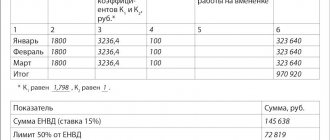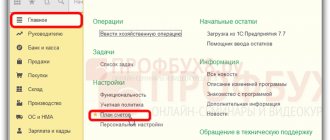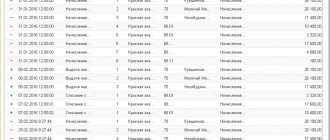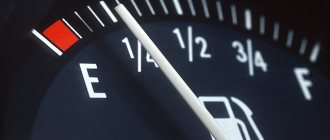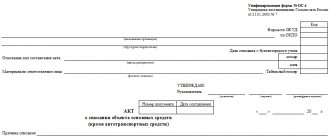What is fuel and lubricants
Fuel and lubricants is a generally accepted abbreviated name for a group of fuels and lubricants. These include:
- various types of fuel (diesel, gasoline, gas);
- special fluids for vehicles (brake, cooling);
- oils and lubricants (motor oils, transmission oils, various lubricants, etc.).
Fuel and lubricants can be used by both specialized transport enterprises and ordinary companies that have vehicles used for various needs.
How to write off fuel and lubricants using waybills
A waybill (PL) is a primary accounting document that reflects the mileage of vehicles. With its help you can calculate the consumption of fuel materials.
Specialized transport organizations that use vehicles to carry out their main activities are required to use the PL with the details that are specified in the order of the Ministry of Transport of Russia “On the procedure for filling out the PL” dated September 18, 2008 No. 152.
Attention! Changes have been made to Order No. 152 and from March 1, 2019, you will need to fill out travel forms in a new way. We talked in more detail here.
Enterprises for which the use of vehicles is not the main activity can independently develop a form of PL and consolidate it in their accounting policies. However, it is important not to forget about the provisions of the Law “On Accounting” dated December 6, 2011 No. 402-FZ. And yet, most often, enterprises prefer to use the PL form from the Decree of the State Statistics Committee of the Russian Federation dated November 28, 1997 No. 78. For a sample of filling out a waybill, see here.
Each DP must be noted in a special registration log. In practice, the question often arises with what regularity it is necessary to issue a PL. Clause 10 of Order 152 states that the PL can be drawn up for 1 day or for a period of no more than 1 month.
Specialized transport enterprises are recommended to draw up PLs daily in order to confirm their expenses and record the time worked by drivers. An exception is the case when the driver was sent on a business trip for a period exceeding 1 day (shift).
Companies that use vehicles for their needs and are not specialized can issue a license as needed, for example, once every 2 weeks or once a month (Resolution of the Federal Antimonopoly Service of the North-Western District dated February 11, 2009 No. A56-10236/2007).
The Ministry of Finance notes that PLs must be issued with such regularity that on their basis one can confidently judge the need for spent fuel and lubricants and the accounting of time worked by drivers (letter of the Ministry of Finance of the Russian Federation dated 04/07/2006 No. 03-03-04/1/327, dated 16.03 .2009 No. 03-03-04/2/77).
Accounting by cards
The plastic fuel card payment system is the most convenient and profitable form of payment for fuel. The organization enters into an agreement with a fuel and lubricants supplier for the purchase of gasoline using a fuel card, which stores information about the established limits on the quantity and range of petroleum products and related services, as well as the amount of money within which petroleum products and related services can be obtained.
The posting of the cost of a fuel card (if there is one, since in most cases the card is used for free if it is returned) can be registered as a receipt - “Receipt (acts, invoices)” - create a receipt “Services (act)”).
Fig.1 Creation of the “Services” document
Fig. 2 Filling out a service document - production of a fuel card
In this case, the fuel card itself is taken into account as a strict reporting form on off-balance sheet account 006 and is reflected in accounting using a manual operation - menu “Operations” - “Operations entered manually”.
Fig.3 Operation entered manually – reflection of the fuel card as off-balance
Please note that if a fuel card is produced free of charge, the card is also displayed on off-balance sheet account 006 “Strict reporting forms” at a conditional price - 1 card = 1 ruble.
At the end of the month, the fuel supplier provides documents reflecting the number of liters actually purchased, which is the basis for accounting in account 10.03 “Fuel” and is issued through “Receipt of goods (invoice)”, in the “Purchases” menu - “Receipts (acts, invoices)” .
Fig.4 Menu of the 1C: Accounting program “Purchases”
We create a new document “Receipt of goods (invoice), fill in the organization, supplier, contract, warehouse and add rows to the tabular part “Goods” using the “Add” or “Selection” button. When creating an item, be sure to specify the type of item - fuels and lubricants.
Fig.5 Nomenclature card for fuels and lubricants
Fig.6 Registration of receipt of fuel and lubricants
Thus, we received fuel and lubricants from the supplier. The wiring has been formed - Dt. 10.3 - Kt. 60.
Fig.7 Movement of the document “Receipt of goods (invoice)”
Rules for writing off fuel and lubricants based on waybills
The procedure for writing off fuel and lubricants according to waybills involves 2 methods of writing off: according to the standard or according to the fact. In order to figure out when and what method to use, let’s turn to the PL form itself.
Let's assume that the enterprise uses the PL from Resolution 78. The forms of this document contain a column for indicating fuel consumption. The columns of this column reflect how much fuel was in the tank when the vehicle left, how much was issued, and how much was left in the tank when the vehicle returned. In this case, it is possible to calculate the actual fuel consumption for the submarine. Non-specialized transport enterprises, when independently developing their own plans, can also include these columns in the document. Then there will be no difficulties in actually calculating the spent fuel and lubricants.
Section II of Order 152 does not indicate the reflection of turnover in the movement of fuel resources as mandatory details. At the same time, in paragraph 6 of this document you can see the requirement to indicate the odometer readings when leaving and returning the vehicle, that is, mileage in kilometers.
How to write off fuel and lubricants according to waybills in cases where the fuel turnover is not indicated in the PL? You can use the write-off of fuel and lubricants according to the standard - the rules for such write-off are given in the order of the Ministry of Transport of Russia dated March 14, 2008 No. AM-23-r. The document contains standard fuel costs for various brands of cars and the procedure for calculating fuel costs according to the distance traveled by vehicles.
The resulting data is the basis for reflecting spent fuel and lubricants in accounting. For tax accounting purposes, you can use either method. The Tax Code of the Russian Federation does not directly stipulate that fuel and lubricants expenses are accepted for tax accounting only based on actual expenses incurred.
A ready-made solution from ConsultantPlus will help you calculate fuel consumption according to standards. Sign up for a free trial to learn the material.
How to take into account the fuel in the tank of a sold car
The opposite situation is also possible, when an organization sells a car, and with it the fuel in the tank. Here it is best to include a separate clause in the purchase and sale agreement, where the volume and price of gasoline should be indicated. This will make it possible to show the implementation of fuels and lubricants separately from the implementation of the machine. From a legal point of view, everything will be correct, because no license is required to sell fuel.
Keep a book of income and expenses, generate reports according to the simplified tax system in the web service Maintain for free
In the absence of a special clause in the agreement, the disposal of gasoline must be carried out as a debit to account 91 and a credit to account 10. Such expenses cannot be reflected in tax accounting, since the value of gratuitously transferred property does not reduce taxable income (sub. 16, Article 270 of the Tax Code of the Russian Federation).
Calculation of waybills for the write-off of fuel and lubricants
Let's consider a practical example of calculating waybills for writing off fuel and lubricants.
Example
In August 2021, Zarnitsa Plus LLC purchased 200 liters of gasoline for a total amount of 8,000 rubles. in view of VAT. At the same time, as of August 1, 2019, there were 80 liters of gasoline in stock at a price of 38 rubles. per liter A VAZ-21214-20 Chevrolet Niva car was filled with gasoline. This car is used for business trips by employees of the Zarnitsa Plus accounting department. The accounting policy at the enterprise has adopted the method of accounting for fuels and lubricants at average cost.
The company operates in the Chelyabinsk region.
Let's determine the average cost of writing off fuel and lubricants in March and calculate fuel consumption in the current month in two ways: according to fact and according to the standard.
| Dt | CT | ∑, rub. | Content |
| 10 | 60 | 6 666,67 | Receipt of gasoline from the supplier |
| 19 | 60 | 1 333,33 | VAT |
Let's calculate the average cost of gasoline in August 2021:
Subscribe to our newsletter
Yandex.Zen VKontakte Telegram
(80 l × 38 rub. + 6,666.67 rub.) / (80 l + 200 l) = 34.67 rub.
- Write-off of gasoline after the fact.
In August 2021, 1 vehicle departure was made for official purposes. The PL states that when leaving, there were 40 liters of gasoline in the Niva’s tank, 20 liters were issued, and when returning back to the enterprise, the remainder in the tank was 30 liters.
Let's determine the actual fuel consumption:
40 l + 20 l − 30 l = 30 l.
The amount of gasoline write-off in March will be:
30 l × 34.67 rub. = 1040.10 rub.
| Dt | CT | ∑, rub. | Content |
| 26 | 10 | 1 040,10 | Gasoline written off for general business needs |
- Write-off of gasoline according to the standard.
Let's assume that the submarine does not reflect the fuel speed. The company uses PL with odometer readings.
The submarine produced about: at the beginning of the trip 5000 km, after returning to the enterprise - 5070 km. Let us turn to order No. AM-23-r.
In paragraph 7 of the document you can see the formula for calculating fuel consumption:
Qн = 0.01 × Hs × S × (1 + 0.01 × D),
Where:
Qn — standard fuel consumption, l;
Hs—basic fuel consumption rate for vehicle mileage, l/100 km;
S—vehicle mileage, km;
D — correction factor (total relative increase or decrease) to the norm, %.
In sub. 7.1 of the document we find Hs for our car - 10.9 liters.
Coefficient D is found in Appendix No. 2 to the document - 10% (for the Chelyabinsk region).
Let's determine gasoline consumption in March:
0.01 × 10.9 l × 70 km × (1 + 0.01 × 10%) = 8.4 l.
The amount of gasoline write-off in March will be:
8.4 l × 34.67 rub. = 291.23 rub.
| Dt | CT | ∑, rub. | Content |
| 26 | 10 | 291,23 | Gasoline written off for general business needs |
***
Accounting for the write-off of fuel and lubricants must be organized at each enterprise where vehicles are used and fuel and lubricants are consumed. It does not matter whether the organization is a specialized transport company.
Fuel resources are written off on the basis of the main primary document - PL. There are certain rules for writing off fuel and lubricants based on waybills. The costs of fuel and lubricants can be determined by fact or by standard. The cost of writing off fuel and lubricants in accounting is calculated using the FIFO method or the average cost method. For tax accounting purposes, you can use either method.
You can find more complete information on the topic in ConsultantPlus. Free trial access to the system for 2 days.
Compensation for the use of a personal car
Sometimes the work of some company employees requires frequent travel. For business trips, an employee can use his personal car. In this case, the company can pay him appropriate compensation.
In accordance with Article 188 of the Labor Code of the Russian Federation, when using personal property, including a personal car, with the consent and in the interests of the employer, the following payments are provided:
- compensation for the use and wear and tear (depreciation) of personal property;
- reimbursement of expenses associated with the operation of personal property.
The amount of compensation is determined by the employer by agreement with the employee. As a rule, the amount of compensation depends on the intensity of use of the car.
To receive compensation, the employee must submit to the accounting department a notarized copy of the vehicle’s technical passport. If he drives a vehicle under a power of attorney, he must provide a copy of the power of attorney. Compensation is paid monthly based on the order of the head of the organization.
Expert “NA” E.P. Abramova
